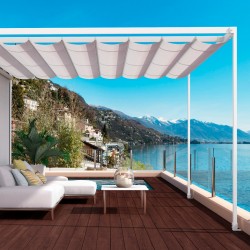Call the professionals: If you have problems with your awning or are unsure how to properly maintain it, call the professionals for help. They will be ab
how to properly care for the awning?
Seek professional advice: Finally, it's always a good idea to seek professional advice when choosing an awning. A reputable awning dealer or installer can provide guidance on the best type and design of awning for your specific needs and can ensure that the awning is properly installed.
Consider your budget: Awnings can vary in price depending on the type, material, and size. Determine your budget and choose an awning that meets your needs and fits within your budget.
Choose the right material: Awnings are typically made of fabric or metal, and each material has its advantages and disadvantages. Fabric awnings are more flexible and can be easily retracted, while metal awnings are more durable and require less maintenance.
Choose the right style: Awnings come in a variety of styles and designs, so choose one that complements the architecture and design of your home or building. Consider the color, material, and pattern of the awning as well.
Consider the size and location: The size and location of the space you want to cover will also play a role in selecting the right awning. Measure the area where you want to install the awning and consider factors such as the angle of the sun and prevailing winds.
Determine the purpose: The first step in choosing the right awning is to determine what you want to use it for. Do you want to create shade over a patio or outdoor seating area, or do you want to reduce energy costs by blocking sunlight from entering windows? Understanding the purpose of the awning will help you select the appropriate type and design.
Choosing the right awning can depend on several factors, including the intended use, the size and location of the space you want to cover, the style and design of the awning, and your budget. Here are some tips on how to choose the right awning:
how to choose the right awning?
Overall, the market for awnings is quite diverse, and the specific market segments that purchase them the most will depend on factors such as geography, climate, and local building codes and regulations.
In addition to homeowners, businesses such as restaurants and cafes also purchase awnings to create outdoor seating areas and attract customers. Hotels and resorts also commonly use awnings to provide shade for pool and patio areas. Retail stores use awnings for branding and advertising purposes, as well as to provide shelter for customers entering and exiting the store.
Awnings are purchased by a wide range of individuals and businesses, including homeowners, restaurants, cafes, hotels, and retail stores. However, homeowners are typically the largest market for awning sales, as they use them to enhance the appearance of their homes, provide shade and shelter for outdoor living spaces, and reduce energy costs by blocking sunlight from entering windows.
Overall, the type of marquise or awning you choose will depend on your specific needs, budget, and the intended use.
Portable awnings: These are lightweight and can be easily transported and set up, making them ideal for outdoor events or camping trips.
Motorized awnings: These are similar to retractable awnings, but they can be extended or retracted using a remote control.
Commercial awnings: These are used for branding and advertising purposes and are commonly seen on storefronts, restaurants, and hotels.
Canopies: These are freestanding structures that are commonly used for outdoor events or as carports.
Shade sails: These are large pieces of fabric that are stretched between posts or anchored to a building to provide shade over a patio or outdoor seating area.
Window awnings: These are installed over windows to provide shade and reduce energy costs by blocking sunlight from entering a building.
Door awnings: These are installed over entry doors to provide shelter from rain or snow.
Fixed awnings: These are permanently installed and cannot be retracted. They are commonly used over windows, doors, and storefronts.
Retractable awnings: These can be extended or retracted using an electronic motor or manually using a crank handle. They are typically installed over patios, decks, or outdoor seating areas.
There are many types of marquises (also known as awnings or canopies) available, including:
Awnings are typically used as a form of shade or shelter from the sun, rain, or wind. They are commonly installed over windows, doors, patios, decks, and outdoor seating areas to provide protection from the elements and create a more comfortable outdoor living space. Awnings can also help reduce energy costs by blocking sunlight from entering windows and heating up indoor spaces. Additionally, awnings can add aesthetic value to a home or building by enhancing its exterior appearance.
























